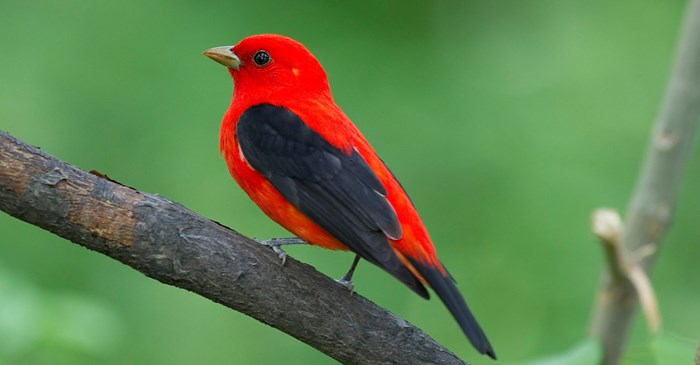When taking a hike through the woods, look up - way up! - for a brightly hued songbird with vibrant colors that looks as though it would seem more at home in the tropics.
The male Scarlet Tanager makes some people think of a Red-winged Blackbird in reverse. His body is a deep orangey-red with jet black in the wings and tail. And just like the Red-winged Blackbird, you might say the female was overlooked during the naming of the Scarlet Tanager. The ladies have yellow plumage with olive-green wings.
Finding the Scarlet Tanager
The Scarlet Tanager is at home in the treetops, especially in large, uninterrupted forests with plenty of mature oaks. They spend much of their summers picking insects from tree bark and leaves, or zipping around catching insects in flight.
Before your next hike, take a moment to learn their songs and calls because they are easiest to locate by sound. The male song is likened to "a robin with a cold.” Their chip-burr, on the other hand, is easy to pick out. Once you hear it, start looking.
While the Scarlet Tanager prefers large, uninterrupted forests, they do at times settle and nest in smaller woodlands. Here, their nests can play host to Brown-headed Cowbird eggs, which means the much larger cowbird nestling bird often outcompetes the smaller Scarlet Tanager nestlings.
In the Yard
As the Scarlet Tanager migrates to its breeding grounds, those who live in the Gulf Coast states might spot them in their backyards. Those who live near the woods or have plenty of mature trees around the property might also catch a backyard glimpse of these flashy birds.
To make the Scarlet Tanager feel at home in your yard, keep in mind they are drawn to berry plants, such as chokecherries, blueberries and mulberries. Or set out Lyric Fruit & Nut High Energy Wild Bird Mix, which features cranberries, and raisins. Like everything else in our lineup, this blend is handcrafted and bird-tested.
